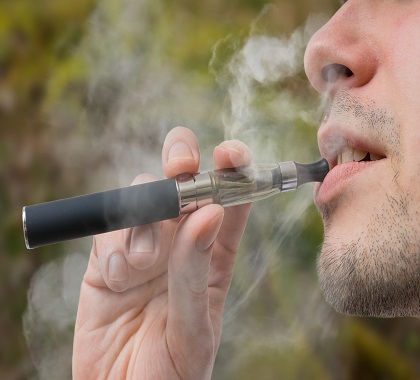To offset the cost of increasing the smoking and vaping age to 21, Washington State legislators are now considering two tax proposals that would expand the state’s tobacco tax to vaping products.
The first proposal would expand an existing tax on tobacco products – the Other Tobacco Product (OTP) rate of 95 percent of the wholesale price – to vaping products such as electronic cigarettes and vape pens. The expanded tax, which is estimated to generate $40 million over the next two years, would not be applied to special cartridges designed to help people stop smoking or marijuana vaping products.
The second proposal would impose a 60 percent tax on all vapor products, including those without nicotine. The funds from this tax would initially be used to cover the cost of the minimum smoking age increase. After 2021, 60 percent of the revenue would be directed to the state’s general fund. The remaining 40 percent would be sent to the essential public services account.
New and increased taxes on vaping products have not proven successful in other states. Pennsylvania serves as one cautionary tale. In 2016, Pennsylvania imposed a vaping tax on “40% of the purchase price of the wholesaler or manufacturer.” Less than a year later, Pennsylvania state legislators began attempting to reverse or reduce the scope of the tax. In a March 2017 news release, one legislator said the 40 percent tax “has already resulted in the closure of more than 100 small businesses and the loss of several hundred jobs in the industry.”
Discouraging smoking is a laudable goal – so why tax a less-harmful alternative? E-cigarette taxes have many negative effects, including driving residents to buy untaxed or lower-taxed products elsewhere, reducing revenues for retailers in the state, and unduly burdening low- and moderate-income families.
Research suggests e-cigarettes are particularly helpful for heavy smokers who have tried and failed to quit through traditional methods – such as nicotine gum, the nicotine patch, and medication. E-cigarettes have proven to be effective products for tobacco harm reduction. Dr. Brad Rodu, senior fellow for The Heartland Institute, has over 20 years of experience researching and educating the public about alternative nicotine delivery systems, including smokeless tobacco products, such as e-cigarettes. In a booklet titled “Vaping, E-Cigarettes, and Public Policy Toward Alternatives to Smoking,” Rodu wrote, “It is the smoke produced by burning tobacco, not the ingestion of nicotine, that ought to be the target of public health campaigns.”
Imposing excise taxes on vapor products is not justified from a public health perspective, and it removes a prime economic incentive for smokers to improve their health by switching to e-cigarettes. The American Association of Public Health Physicians has concluded e-cigarettes “could save the lives of 4 million of the 8 million current adult American smokers who will otherwise die of a tobacco-related illness over the next 20 years.”
Taxes on vapor products are highly regressive and unduly burden moderate- and low-income individuals. In a Cato Journal article, Kevin Callison and Robert Kaestner found from “2010 to 2011, smokers earning less than $30,000 per year spent 14.2 percent of their household income on cigarettes, compared to 4.3 percent for smokers earning between $30,000 and $59,999 and 2 percent for smokers earning more than $60,000.” This would be true for vapor products as well, since the overwhelming majority of people who vape are or were smokers.
Targeted taxes such as those on vapor products disproportionately harm low-income taxpayers, punish local businesses, and deter smokers from quitting more harmful combustible cigarettes.
The following documents provide additional information on tobacco taxes and other “sin” taxes.
Vaping, E-Cigarettes, and Public Policy Toward Alternatives to Smoking
https://heartland.org/publications-resources/publications/vaping-e-cigarettes-and-public-policy-toward-alternatives-to-smoking
For decades, lawmakers and regulators have used taxes, bans, and burdensome regulations as part of their attempt to reduce the negative health effects of smoking. Recently, some have sought to extend those policies to electronic cigarettes. This booklet from The Heartland Institute urges policymakers to re-think that tax-and-regulate strategy. Policymakers should be mindful of the extensive research that supports tobacco harm reduction and understand bans, excessive regulations, and high taxes on e-cigarettes often encourage smokers to continue using more-harmful traditional cigarette products.
Qualitative Study on E-cigarettes Shows More Evidence of Tobacco Harm Reduction
https://heartland.org/publications-resources/publications/qualitative-study-on-e-cigarettes-shows-more-evidence-of-tobacco-harm-reduction?source=policybot
In this Research & Commentary, Heartland Institute Government Relations Coordinator Lindsey Stroud examines a study, published in The International Journal of Environmental Research and Public Health in June 2016, that provides additional evidence showing e-cigarettes and vaporized nicotine products (VNPs) are an effective tobacco harm-reduction tool.
Heartland Daily Podcast – Chris Hughes: On the Front Lines of the FDA’s War on Vaping
https://heartland.org/news-opinion/news/heartland-daily-podcast–chris-hughes-on-the-front-lines-of-the-fdas-war-on-vaping?source=policybot
Chris Hughes, owner of Fat Cat Vapor Shop and former president of the Pennsylvania chapter of the Smoke Free Alternatives Trade Association (SFATA), joins the Heartland Daily Podcast to talk about the U.S. Food and Drug Administration’s new deeming rules on vaping.
Nicotine Without Smoke: Tobacco Harm Reduction
https://heartland.org/policy-documents/nicotine-without-smoke-tobacco-harm-reduction
This report provides an update on the use of tobacco harm reduction strategies related to non-tobacco nicotine products, particularly e-cigarettes. The authors conclude for all the potential risks involved, harm reduction has significant potential to prevent death and disability caused by tobacco use and to hasten the nation’s progress toward a tobacco-free society.
Three Reasons to Avoid Tobacco Taxes
http://www.commonwealthfoundation.org/policyblog/detail/three-reasons-to-avoid-tobacco-taxes
Elizabeth Stelle of the Commonwealth Foundation examines Pennsylvania’s proposed tobacco tax hikes. Stelle argues they are the wrong prescription for the state, and she outlines several reasons why they are harmful.
Five Things to Consider Before Raising Tobacco Taxes: A Review of the Research
https://heartland.org/policy-documents/five-things-consider-raising-tobacco-taxes-review-research
This Heartland Institute Policy Brief argues, “Tax increases above current levels are not justified by appealing to the costs smokers impose on nonsmokers. Smokers already pay more than this measure could justify.”
Peering Through the Mist: Systematic Review of What the Chemistry of Contaminants in Electronic Cigarettes Tells Us about Health Risks
http://heartland.org/policy-documents/peering-through-mist-systematic-review-what-chemistry-contaminants-electronic-cig
Electronic cigarettes are generally recognized as a safer alternative to combusted tobacco products, but there are conflicting claims about the potential health concerns these products may present. This paper reviews the available data on the chemistry of aerosols and liquids of electronic cigarettes and compares modeled exposure of vapers with occupational safety standards.
Research & Commentary: New CDC Report Finds Vaping Helps Smokers Quit
https://heartland.org/policy-documents/research-commentary-new-cdc-report-finds-vaping-helps-smokers-quit
A report released by the Centers for Disease Control and Prevention (CDC) found only 0.4 percent of the people who had never smoked tobacco in a CDC study group are current vapers, which the report defines as using a vaping device either every day or some days. The CDC report, the first of its kind, estimates e-cigarette use among U.S. adults using a nationally representative household survey. The report finds only 3.4 percent of adults who have never smoked have tried an e-cigarette; 12.6 percent of Americans have tried an e-cigarette; and fewer than 4 percent of the U.S. population are regular e-cigarette users.
E-Cigarettes Are Making Tobacco Obsolete. So Why Ban Them?
http://heartland.org/policy-documents/e-cigarettes-are-making-tobacco-obsolete-so-why-ban-them
Matt Ridley reports vaping works better than any other method of giving up smoking, and he examines several studies reaching this conclusion. Ridley asks why cities are banning vaping products given the large amount of evidence present showing their success in helping smokers quit.
E-Cigarette Primer for State and Local Lawmakers
http://heartland.org/policy-documents/e-cigarette-primer-state-and-local-lawmakers
Joel Nitzkin provides evidence e-cigarettes work as a tobacco harm reduction modality and reviews the arguments against them. He closes with recommendations for actions state and local lawmakers should and should not consider regarding tobacco harm reduction and e-cigarettes.
Nothing in this Research & Commentary is intended to influence the passage of legislation, and it does not necessarily represent the views of The Heartland Institute. For further information on this and other topics, visit the Budget & Tax News website, The Heartland Institute’s website, and PolicyBot, Heartland’s free online research database.
The Heartland Institute can send an expert to your state to testify or brief your caucus; host an event in your state, or send you further information on a topic. Please don’t hesitate to contact us if we can be of assistance! If you have any questions or comments, contact John Nothdurft, Heartland’s director of government relations, at [email protected] or 312/377-4000.





